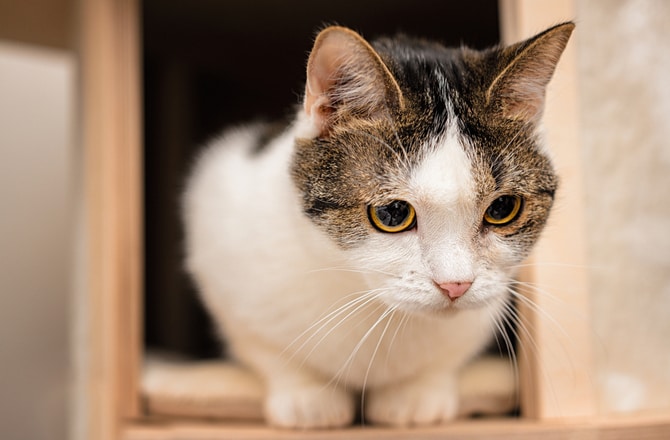Homology and Analogy
1.
a. Cats and humans are both mammals. Cats have evolved to be hunters in the wild while
humans have evolved to be omnivorous and hyper intelligent. This being said, the common
ancestor between humans and cats is closer than that of many other animals. Among their
similarities is the distinct bone structure of cat paws and human hands.
humans have evolved to be omnivorous and hyper intelligent. This being said, the common
ancestor between humans and cats is closer than that of many other animals. Among their
similarities is the distinct bone structure of cat paws and human hands.
b. They both have a joint structure and individual digits. The primary difference between them
is that humans have thumbs, allowing them to grab onto things. Cats do not have this ability
but they do have claws that help them hunt. These two species evolved separately from each
other, developing traits that gave them distinct advantages in the wild. Cats became agile and
stealthy while humans began to walk on two feet and make usable tools with their thumbs.
is that humans have thumbs, allowing them to grab onto things. Cats do not have this ability
but they do have claws that help them hunt. These two species evolved separately from each
other, developing traits that gave them distinct advantages in the wild. Cats became agile and
stealthy while humans began to walk on two feet and make usable tools with their thumbs.
c. The common ancestor between cats and humans was likely a small mammal with paw-like
appendages. We know that this common ancestor had these is because humans and cats
both have them in the same way. It is clear that cats and humans did not independently
evolve hands or paws.
appendages. We know that this common ancestor had these is because humans and cats
both have them in the same way. It is clear that cats and humans did not independently
evolve hands or paws.
d.
2.
a. The platypus is and interesting mammal that is not only semi aquatic, but lays eggs.
The duck is a bird that has similar traits also being semi aquatic and laying eggs.
The duck is a bird that has similar traits also being semi aquatic and laying eggs.
b. Both the platypus and the duck lay eggs on land that later hatch their offspring. These two
species also live and operate similarly to each other. They live both on land and in the water
simultaneously and likely have similar diets as a result.
species also live and operate similarly to each other. They live both on land and in the water
simultaneously and likely have similar diets as a result.
c. Though both of these animals lay eggs, it is not likely that their common ancestor laid eggs
on land like these two animals do. The common ancestor likely laid eggs underwater. We
know that this trait is analogous because the laying of eggs not a common practice in other
mammals like the platypus. The platypus developed completely independently of birds.
on land like these two animals do. The common ancestor likely laid eggs underwater. We
know that this trait is analogous because the laying of eggs not a common practice in other
mammals like the platypus. The platypus developed completely independently of birds.
d.



Great post!!! Cats and humans work differently by how they use their joint structure, yet still have that joint structure in common. I used a human being as one of the two homologous traits. I think it's very interesting to see all the different animals that we share a lot of the same traits with. I had no idea! Truly makes you think about all the different ancestors each animal had, and how all these animals came about.
ReplyDeleteThe text is disappearing off of your page, amking it nearly impossible to read. I'm going to request that you fix the problem and then email me so I will know to come back and grade it.
ReplyDeleteGood evening Evan,
ReplyDeleteGreat job coming up with the examples that you have provided. I wasn't sure if we were allowed to compare humans with animals, as that was a thought I had. Cats and humans do very much have things in common. It is interesting you used them as an example for homologous because I thought it would be great to compare their analogous traits such as the similarity in heart, lungs, digestive system, urinary tract, and sex organs. The reason I bring this up is due to having all of these same functions, but not visibly the same structure. However, you brought up a great point by bringing up their differences, such as thumbs and claws. They both are very different, developed in similar environments, but they both developed different forms of hunting. Thats another thing they have in common, both humans and cats enjoy hunting for pleasure. I was very interested while reading your analogous post because I never knew that the platypus payed eggs. Great job introducing this to the reader!
Okay on your opening sections (homology and analogy), but this was your opportunity to more fully describe these organisms to offer a clearer picture to your readers about what might have driven the evolution of these traits.
ReplyDeleteIt would have helped clarify your discussion on homology if you had focused on one particular trait. For example, you discuss the use of the human thumb. Well, the first digit on the forehands/forepaws of each organism would have been a good comparison. But then look at the cat. The comparable structure is not the claw. It's the bone structure itself. Why didn't cats develop thumbs? What's advantageous about the structure they do have instead? How can you connect these differences with the differences in their environments?
In general, good information in ancestry. The key is not the "paw" like structure but the number of digits. The ancestor possessed the typical five digit structure, particularly with that first digit which could be the focus of your discussion. That trait was passed onto these two extant species, with changes occurring along the way due to environmental differences. That's what we need to know to confirm homology.
RE: analogy
If the trait in question is egg-laying (which is a valid analogous pair), then that is where the focus of your discussion should be. So these two organisms share this trait. Can you discuss this in terms of similar function and similar environmental pressures? This is especially important for the platypus since they evolve from placental animals. Why would a placental mammals make the significant change to egg-laying? What advantage did this provide?
"...it is not likely that their common ancestor laid eggs on land like these two animals do"
But that's what we are trying to figure out and what we need to know to confirm analogy.
"The common ancestor likely laid eggs underwater."
Do you know this or are you guessing?
Here's how you would use ancestry to confirm that these traits are analogous:
The platypus arose from mammals, who arose from reptiles. Birds also arose from reptiles, and they actually inherited the egg-laying trait from reptiles. So is it possible that the egg-laying trait is homologous, not analogous? Well, that depends upon how it arose in the platypus. We know that the platypus developed it's trait after it split off from mammals, who are generally placental in nature. That means this trait arose independently in the platypus relative to that common ancestor with birds. That's what we need to know to confirm that these traits are, indeed, analogous.
Good images.